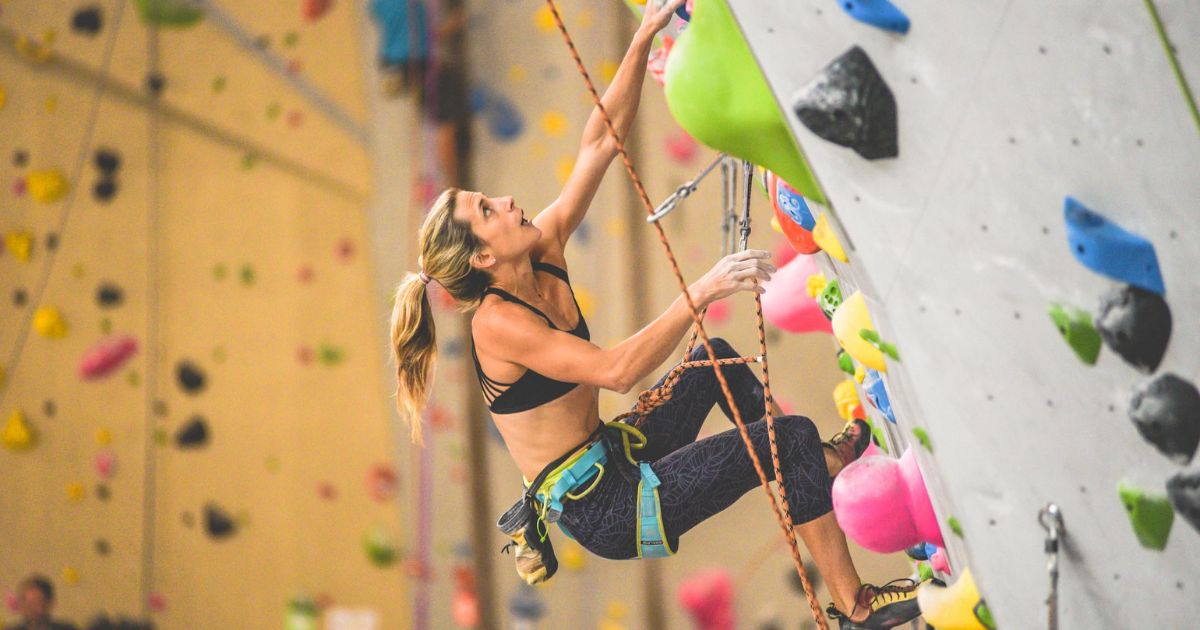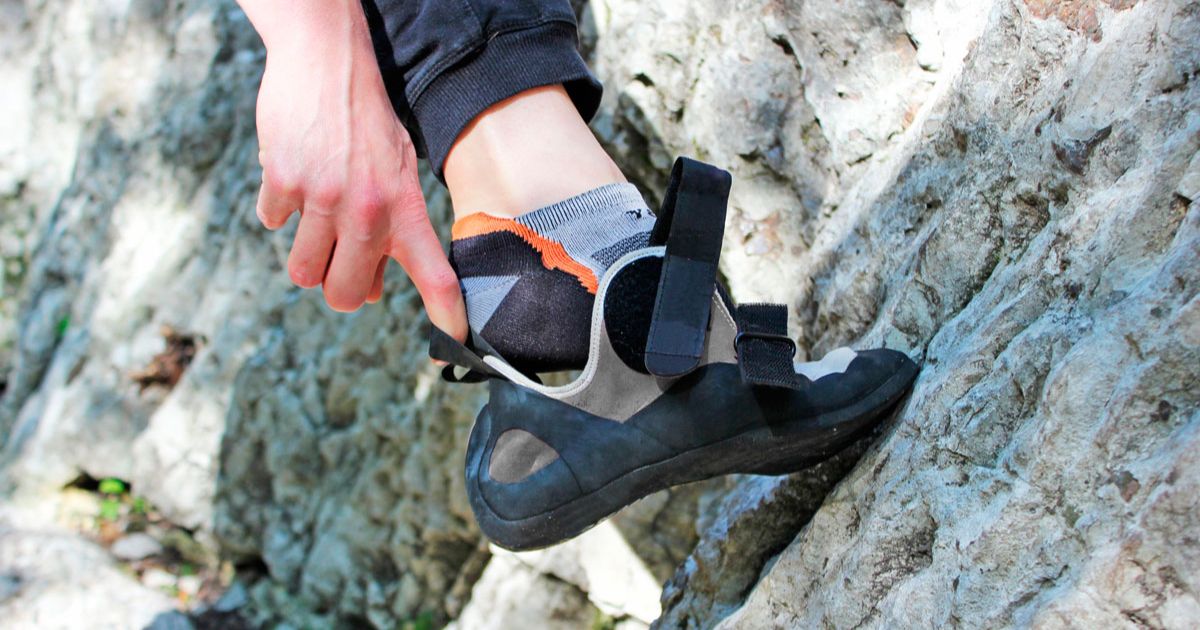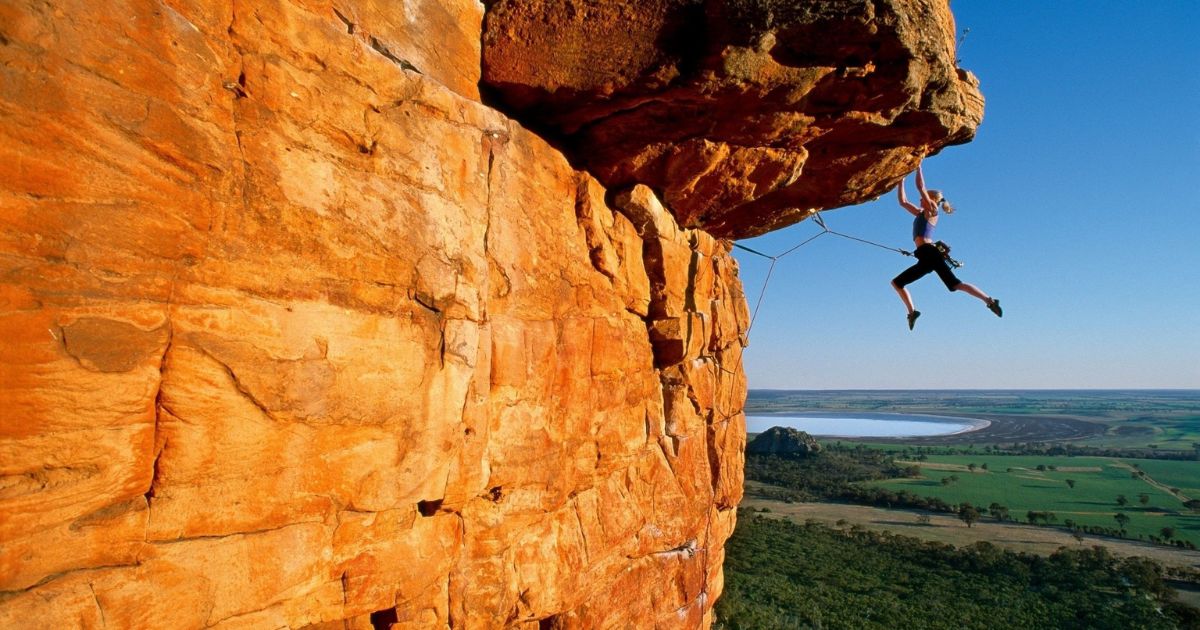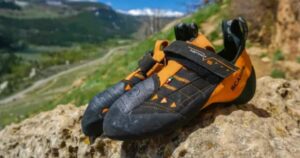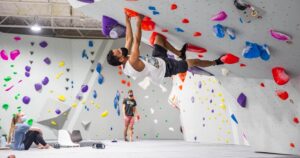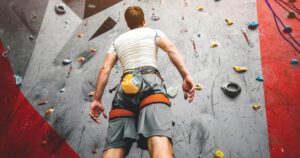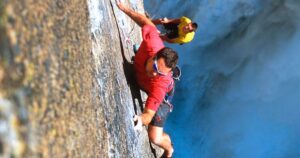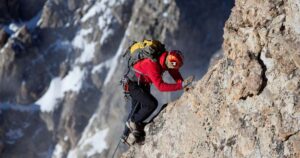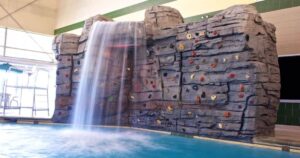New climbers often ask, “What should I wear to go rock climbing?” Rock climbing does not have set rules for clothing like some sports. You do not need a special uniform. Some climbers even climb in jeans, though others may think that is crazy. While there is no one best outfit for climbing, here are some tips to help you choose comfortable clothes to improve your climbing experience.
Key Takeaways
- Climbing shoes should be chosen based on the level of experience and the type of climbing being done.
- Comfortable and flexible clothing is important for a full range of motion and to avoid hindering performance.
- A well-fitting climbing harness is essential for safety and support during gym sessions.
- Using chalk and a chalk bag can improve grip, reduce sweat, and increase confidence during climbs.
Proper Climbing Shoes
Proper climbing shoes are an essential piece of equipment for any rock climber at a gym, providing the necessary grip and support for optimal performance and safety. When it comes to climbing shoe types, there are three main categories: neutral, moderate, and aggressive. Neutral shoes offer a flat sole and are suitable for beginners or those who prefer comfort over performance.
Moderate shoes have a slightly downturned shape and are suitable for climbers who want a balance between comfort and performance. Aggressive shoes have a highly downturned shape that maximizes power and precision, making them ideal for advanced climbers tackling difficult routes.
To ensure a proper fit, follow this shoe fitting guide: First, determine your street shoe size and then go down a half to full size for a snugger fit. Make sure your toes are slightly curled but not painfully cramped. The shoe should feel tight but not restrictive, allowing for toe movement and flexibility. Finally, try on different brands and models to find the one that suits your foot shape and climbing style. Remember, finding the right climbing shoes is crucial for your performance and safety on the wall.
Comfortable and Flexible Clothing
When it comes to rock climbing at the gym, it is important to wear comfortable and flexible clothing that allows for a full range of motion. Climbing requires dynamic movements and flexibility, so wearing restrictive or uncomfortable clothing can hinder performance and increase the risk of injury. To ensure comfort and flexibility, consider layering options and choosing moisture-wicking fabrics.
Layering allows you to add or remove clothing as needed to regulate body temperature during your climb. Moisture-wicking fabrics, such as synthetic blends or merino wool, help to pull sweat away from your skin, keeping you dry and comfortable. These clothing choices not only enhance your climbing experience but also contribute to a sense of belonging in the climbing community. Now, let’s move on to discuss the importance of a climbing harness.
Climbing Harness
To ensure optimal safety and support during your rock climbing gym sessions, it is essential to wear a well-fitting climbing harness. There are different types of climbing harnesses available, each designed for specific climbing activities and body types. When choosing the right climbing harness, consider factors such as comfort, durability, and adjustability. Look for harnesses with padded waist belts and leg loops for added comfort during long climbing sessions.
Additionally, adjustable leg loops allow for a customized fit. Pay attention to the harness’s weight and construction materials, as these can impact its durability and performance. By selecting a harness that fits well and meets your specific needs, you can climb with confidence and focus on enjoying your rock climbing experience. Now let’s move on to the next essential item, the chalk bag and chalk.
Chalk Bag and Chalk
A chalk bag and chalk are essential equipment for rock climbers at the gym. The use of chalk helps climbers maintain a firm grip on holds, reducing the risk of slipping and falling. The chalk bag, typically worn around the waist or clipped to a harness, provides convenient and accessible storage for the chalk. It allows climbers to easily dip their hands in and apply chalk as needed during their climbs.
There are different types of climbing chalk available, including loose chalk, chalk balls, and liquid chalk. Loose chalk is the most common type, consisting of finely ground magnesium carbonate. Chalk balls are pre-packaged powdered chalk enclosed in a mesh or fabric pouch. Liquid chalk is a suspension of chalk in alcohol or other drying agents, which dries quickly and provides a longer-lasting grip.
Using a chalk bag and chalk offers several benefits, including improved grip, reduced sweat, and increased confidence during climbs. It is important for climbers to choose the type of chalk that suits their preferences and conditions, ensuring a safer and more enjoyable climbing experience.
Helmet for Safety
The helmet is an essential piece of safety equipment for rock climbers at the gym. Wearing a helmet provides several benefits, including protection against falling debris, accidental impacts, and potential head injuries. It is important to choose the right type of helmet for rock climbing, as different helmets offer varying levels of protection and comfort. There are two main types of helmets commonly used by climbers: hardshell helmets and foam helmets.
Hardshell helmets are more durable and offer better protection against sharp objects, while foam helmets are lighter and more comfortable for long climbs. It is crucial to ensure that the helmet fits properly and is securely fastened to provide maximum safety. Transitioning into the subsequent section about climbing gloves, it is equally important to protect your hands while climbing.
Climbing Gloves (Optional)
Some climbers may opt to wear a pair of protective climbing gloves for added grip and hand protection. Here are the benefits of using climbing gloves:
- Enhanced Grip: Climbing gloves provide a better grip on holds, especially in situations where the rock surface is slippery or rough. This gives climbers the confidence and security they need to tackle challenging routes.
- Hand Protection: Climbing gloves offer an extra layer of protection against abrasions, cuts, and blisters. This is particularly beneficial for climbers who engage in long and intense sessions.
- Weather Protection: Climbing gloves can protect your hands from extreme temperatures, whether it’s the cold of winter or the heat of summer. This allows climbers to stay comfortable and focused on their ascent.
- Durability: Good-quality climbing gloves are designed to withstand the rigors of climbing, ensuring they last longer and provide reliable protection.
When choosing climbing gloves, consider factors such as fit, material, and dexterity. Opt for gloves that allow for maximum flexibility and tactile sensitivity, without compromising on durability and grip. Remember, finding the right pair of climbing gloves can greatly enhance your climbing experience and make you feel part of the climbing community.
Accessories and Extras
To complete your climbing gym attire, consider incorporating essential accessories and extras. One important accessory is climbing tape, which provides added grip and protection for your hands. Climbing tape is especially useful for preventing blisters and protecting your skin from rough rock surfaces. It can also be used to support injured fingers or wrists. Another crucial accessory is climbing shoes.
These specialized shoes are designed to provide optimal traction and stability on different types of rock surfaces. They have sticky rubber soles that allow climbers to adhere to the rock, enhancing their grip and preventing slips. Additionally, climbing shoes provide support and protection for your feet, ensuring comfort and reducing the risk of injury. Investing in high-quality climbing tape and shoes will significantly enhance your climbing experience and performance at the gym.
FAQ’s
How Often Should I Replace My Climbing Shoes?
Climbing shoes should be replaced when they show signs of wear and tear, such as a deteriorating sole or a loss of grip. However, breaking in new climbing shoes is crucial to ensure a comfortable and secure fit for optimal performance.
Is It Necessary to Wear a Helmet While Rock Climbing in a Gym?
When rock climbing in a gym, wearing a helmet is not necessary due to the relatively low risk of falling objects. However, it is recommended to prioritize safety by using helmet alternatives such as headbands or beanies.
What Type of Clothing Is Considered Appropriate for Rock Climbing?
Appropriate clothing for rock climbing includes comfortable, flexible attire that allows for a full range of motion. Climbing shoes and a harness are necessary equipment. Dressing appropriately ensures safety and enhances performance.
Are Climbing Gloves Essential for Indoor Rock Climbing?
While climbing gloves can provide extra protection and grip, they are not essential for indoor rock climbing. Developing grip strength through various exercises and techniques is a more effective way to improve climbing performance.
What Are Some Recommended Accessories or Extras to Enhance the Climbing Experience?
To enhance the climbing experience, recommended accessories include climbing chalk to improve grip and a climbing harness for safety and support. These extras can enhance performance and ensure a more enjoyable and secure climbing session.
Conclusion
In conclusion, when heading to a rock climbing gym, it is important to wear the appropriate gear for safety and comfort. This includes proper climbing shoes, comfortable and flexible clothing, a climbing harness, a chalk bag and chalk, a helmet, and optional climbing gloves. One interesting statistic to consider is that approximately 70% of climbing accidents occur due to human error, highlighting the importance of wearing the right gear and practicing proper technique to minimize risks.
